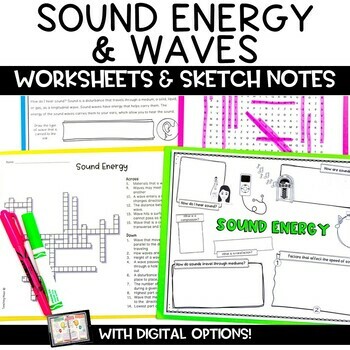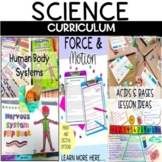Sound Energy and Waves Activity
- PDF
- Google Apps™

What educators are saying
Also included in
- Looking for easy to implement units of study for your physical science curriculum? These activities will help students learn about electricity, magnetism, forms of energy, force and Newton's laws of motion, and simple machines. This curriculum includes science texts, projects, classroom posters, cooPrice $100.00Original Price $117.93Save $17.93
- Looking for a science curriculum to last all school year that will help you teach your physical science, life science, Earth science, and chemistry units? Check out everything this science curriculum has to offer. This year-long science curriculum includes science texts, hands-on activities, classroPrice $326.71Original Price $363.01Save $36.30
- Teach your students about potential, kinetic, and forms of energy using this energy science unit of vocabulary, science texts, review activities, a project, and assessment to engage all student learning types. Students will learn through visual anchor charts, hands-on demonstrations, inquiry activitPrice $15.74Original Price $22.48Save $6.74
Description
Introduce your students to waves and sound energy using science worksheets, graphic organizers, and review activities. Your science students will read to learn about what waves are, the types of waves; longitudinal, transverse, and surface waves, how sound waves interact, what sound is, how it moves, and the properties of sound. Throughout the reading, there are questions and activities to assess knowledge of the concepts. In addition, 3 graphic organizers, a crossword puzzle, a word search, and digital review activities are included for students to sketch and note their understanding of sound energy and waves.
Like this activity? Check out my energy unit and save 20% by clicking here.
Students will learn:
- What are waves?
- Three types of waves: transverse, longitudinal, and surface
- How waves interact with each other: reflection, refraction, diffraction, and interference
- What is sound?
- How sound moves
- Properties of sound
- Pitch
- Resonance
- Intensity
- Loudness
- Frequency
- Doppler Effect
This sound energy lesson includes:
- Sneak Peek into My Classroom: Tips on how I use this lesson with my students
- Digital instructions to use with your secure LMS such as Google Classroom, Schoology, Seesaw, etc
- 8 page science packet, which is broken up into three topics. These topics also include comprehension activities.
- Waves
- Sound Energy
- Properties of Sound
- 21 Google Slides include digital readings, comprehension and vocabulary activities, and graphic organizers
- 3 pages of graphic organizers to complement the three reading topics
- Digital Pirate Hunt Game: Students answer 22 questions related to sound energy and waves
- Awesome 80s color review activity: 9 questions for students to answer and show their knowledge by coloring in the correct response.
- Crossword puzzle
- Word search
- Digital puzzle
- Digital review activity
- Answer key
How to use these sound waves and energy activities in your classroom:
- Science texts: Use these science worksheets or digital notebook to introduce sound waves and energy to your students. Choose to read them as a whole class activity, separate students into small groups, or assign them as independent activities such as homework assignments.
- Graphic organizers: Use these to summarize student learning. Have them work on them independently by referring back to their science text to find answers they do not remember, or have students pair up for a collaborative learning experience.
- Digital Pirate Game: Review concepts introduced in the text with this game. Perfect for struggling learners to gain extra review, reinforcement of concepts, easy sub plans, or an extra help assignment.
- Awesome 80s Coloring Sheet: Students color in the correct response to the 9 questions to demonstrate their knowledge of sound energy and wave behaviors.
- Crossword puzzle: This activity helps students synthesize learning and essential vocabulary terms from the sound waves and sound energy lesson.
- Digital jigsaw puzzle: This activity is similar to the crossword puzzle, digitally using the same clues and terms.
- Word search: Hand out as a preview to the unit or as a fast finisher activity. The word search helps reinforce words that the students will encounter throughout the unit.
- Sub plans: Use these activities as sub plans to reinforce learning when you can't be in the classroom.
- Homework assignment
- Science station
This sound waves lesson will help support your students in meeting NGSS 4-PS3-2.
Teacher feedback:
- My students LOVE the sketch notes pages! They get so excited when they see that we are going to be using them. This resource is a great way for students to take notes and review the information being taught. Thanks!
- I love using these activities! They are so wonderful at reviewing information with students and helping the students organize the content!
- I discovered your sketch notes for the first time and thought that for the price, I would give them a try, and if they didn't go over well, I would not use them again. Wellllllll... the kids LOVED them, and now I have to buy the rest of our science topics or try to create my own for them- Amazing job on these!!!
Other lessons and activities to support your sound energy unit:
Kindly Note: If you have questions, do not hesitate to email me at Teaching Muse Email
PLEASE PREVIEW BEFORE PURCHASING
__________________________________________________________________
Thank you for visiting Teaching Muse. I would love for you to become a follower.
Teaching Muse followers receive new product information and discounts on any new items!
__________________________________________________________________
All rights reserved by Teaching Muse. This product is to be used by the original downloader ONLY. Copying for more than one teacher, classroom, department, school, or school system is prohibited. Additionally, this product may not be distributed or displayed digitally for public view. Failure to comply is a copyright infringement and a violation of the Digital Millennium Copyright Act (DMCA). They are intended for classroom and personal use ONLY.








